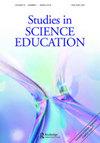Students need more practice with spatial thinking in geoscience education: a systematic review of the literature
IF 9.9
2区 教育学
Q1 EDUCATION & EDUCATIONAL RESEARCH
引用次数: 3
Abstract
ABSTRACT Myriad research in a variety of contexts shows spatial skills benefit students; however, they are not given enough attention in classroom instruction. In this review we systematically explore geoscience education literature focusing on spatial interventions to answer research questions on trends in spatial skills and other characteristics. We narrow our attention to studies published since numerous calls to action to teach more spatial skills in STEM education, resulting in 28 articles for review. To analyse and compare these studies, we organise the literature into a framework of geoscience-relevant spatial skills. We reviewed interventions and assessments to determine the aligning spatial typology skills. Themes of coursework, mapping, and modelling emerged; sub-themes include sketching, gestures, physical models, computer models, and curricular interventions. In the articles reviewed, just over half of the skills identified were intrinsic skills. Future geospatial research should explore how best to incorporate spatial skills into the classroom over long time periods and should focus on the process of spatial reasoning and the strategies students use when problem-solving about spatial phenomena, especially at the elementary and secondary school level. Educators can use the resources outlined in this review to engage in spatialising their curricula.在地学教育中,学生需要更多的空间思维练习:对文献的系统回顾
在各种背景下进行的大量研究表明,空间技能对学生有益;然而,他们在课堂教学中却没有得到足够的重视。在这篇综述中,我们系统地探索了以空间干预为重点的地球科学教育文献,以回答有关空间技能趋势和其他特征的研究问题。我们将注意力集中在自多次呼吁在STEM教育中教授更多空间技能以来发表的研究上,共发表了28篇文章供审查。为了分析和比较这些研究,我们将文献整理成与地球科学相关的空间技能框架。我们回顾了干预措施和评估,以确定调整空间类型学技能。出现了课程、绘图和建模的主题;子主题包括素描、手势、物理模型、计算机模型和课程干预。在审查的文章中,刚刚超过一半的技能是内在技能。未来的地理空间研究应探索如何在很长一段时间内最好地将空间技能融入课堂,并应关注空间推理过程和学生在解决空间现象问题时使用的策略,尤其是在中小学层面。教育工作者可以利用本综述中概述的资源参与课程的空间化。
本文章由计算机程序翻译,如有差异,请以英文原文为准。
求助全文
约1分钟内获得全文
求助全文
来源期刊

Studies in Science Education
EDUCATION, SCIENTIFIC DISCIPLINES-
CiteScore
15.30
自引率
2.00%
发文量
7
审稿时长
>12 weeks
期刊介绍:
The central aim of Studies in Science Education is to publish review articles of the highest quality which provide analytical syntheses of research into key topics and issues in science education. In addressing this aim, the Editor and Editorial Advisory Board, are guided by a commitment to:
maintaining and developing the highest standards of scholarship associated with the journal;
publishing articles from as wide a range of authors as possible, in relation both to professional background and country of origin;
publishing articles which serve both to consolidate and reflect upon existing fields of study and to promote new areas for research activity.
Studies in Science Education will be of interest to all those involved in science education including: science education researchers, doctoral and masters students; science teachers at elementary, high school and university levels; science education policy makers; science education curriculum developers and text book writers.
Articles featured in Studies in Science Education have been made available either following invitation from the Editor or through potential contributors offering pieces. Given the substantial nature of the review articles, the Editor is willing to give informal feedback on the suitability of proposals though all contributions, whether invited or not, are subject to full peer review. A limited number of books of special interest and concern to those involved in science education are normally reviewed in each volume.
 求助内容:
求助内容: 应助结果提醒方式:
应助结果提醒方式:


